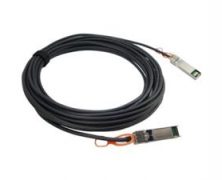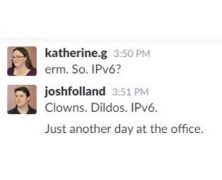Last week I had to head to one of our colocation sites to retrieve some hardware to be moved to another city, and to test out some new swank jank 10GbE switches. These new switches run over SFP+, which means making sure the switches are compatible with the transceivers on the cables. As soon as I discovered this was what was on the to-do list for the day, my stress levels immediately rose. See, SFP+ cables are great in theory. They’ve got a little PCB with a fancy clip, they do 10GbE, and… Well, that’s about it. It’s a cable. It is a conduit for electrons to move. What I hate most about SFP cables is the clip and tab. It’s truly awful design – if you break the plastic tab your only hope for disconnecting the cable is to get a small screwdriver or something similar into the latching mechanism. This is where switch and cable designers must want you to lose your temper. Switch designs, for some brilliant reason, have the ports of the SFP cables oriented such that the latches are facing one another on switches where there’s two rows of ports stacked one on top of another (or, at least the switches I’ve encountered). This means that if you make the mistake (or are forced to due to capacity) of connecting two SFP cables one on top of each other and break the tabs, they’re fused to the switch permanently for all intents and purposes. Depending on the design of the latching mechanism on the cable, there may very well be no feasible way to get a screwdriver or other tool into the gap. I know what you’re thinking. I must be doing it wrong. Like most hardware in IT, there’s...
What’s Good About IPv6? More Addresses.
posted by WeBreakTech
In Breakroom, WeBreakTech staffers staffers chat about the last couple of weeks in tech. What’s new? What’s broken? What are we working on? What makes us want to hurl things into traffic? Sarcasm, salty language, and strong opinions abound. _______________________________________________________________________________________________ Trevor.Pott: So we could discuss the transition to IPv6, which is apparently what I need to do for a client this weekend. Josh.Folland: F*ck IPv6. Trevor.Pott: Dude. Josh.Folland: I get that it’s a necessary evil and it’s got all kinds of great things, but I like remembering *.*.*.40 Katherine.Gorham: What great things? I thought the foot dragging about the move to IPv6 was because there WEREN’T great things. Just vulnerabilities and administrative headache. Trevor.Pott: There aren’t. But we have now reached the point where ISPs aren’t handing out IPv4 addresses to people in the North, and other not-major-urban-centers. If you aren’t on IPv6, you’re not going to be able to serve all customers anymore. And that is a big switch that I have only started to see in the past few months. Katherine.Gorham: Wait… IPv4 doesn’t talk to IPv6? Trevor.Pott: It does not. IPv4 is 32-bit addressing. It CAN’T talk to Ipv6, which is 128 bit addressing. It simply has no way to do so. In order to “transition” to Ipv6, you need to get IPv6 from your ISP (or ask Sixxs nicely for a tunnel and a subnet), then implement BOTH stacks. Katherine.Gorham: But most of the world is still IPv4. Surely someone thought up a workaround? Josh.Folland: …There is not an algorithm to translate it? I never thought they were entirely mutually exclusive. Trevor.Pott: No, there is no direct, supported workaround. There are totally unsupported ways to do it, but in general it was decreed by the ivory tower gods 20 years...


